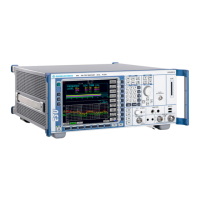Operating Manual 1302.6163.12 - 03 4.147
R&S ESU Instrument Functions
Analyzer Mode
When several traces are being displayed, the marker is set to the maximum value
(peak) of the active trace which has the lowest number (1 to 3). In case a marker is
already located there, it will be set to the frequency of the next lowest level (next
peak).
When the split-screen display mode is active, the marker will be placed in the active
window. A marker can only be enabled when at least one trace in the corresponding
window is visible.
If a trace is turned off, the corresponding markers and marker functions are also
deactivated. If the trace is switched on again (VIEW, CLR/WRITE;..), the markers
along with coupled functions will be restored to their original positions provided the
markers have not been used on another trace.
4.8.10.1 Frequency Measurement with the Frequency Counter
In order to accurately determine the frequency of a signal, R&S ESU is equipped
with a frequency counter which measures the frequency of the RF signal at the inter-
mediate frequency. Using the measured IF, R&S ESU calculates the frequency of
the RF input signal by applying the known frequency conversion factors.
The frequency measurement error depends only upon the accuracy of the frequency
standard used (external or internal reference). Although R&S ESU always operates
synchronously irrespective of the set span, the frequency counter delivers a more
exact result than a measurement performed with a marker. This is due to the follow-
ing:
• The marker measures only the position of the pixel on the trace and infers the
frequency of the signal from this value. The trace, however, contains only a limited
number of pixels. Depending upon the selected span, each pixel may contain
many measurement values, which therefore limits the frequency resolution.
• The resolution with which the frequency can be measured is proportional to the
measurement time. For this reason, the bandwidth is normally made as wide as
possible and the sweep time as short as possible. This results in a loss of
frequency resolution.
For the measurement with the frequency counter, the sweep is stopped at the refer-
ence marker, the frequency is counted with the desired resolution and then the
sweep is allowed to continue.
SIGNAL
COUNT
The SIGNAL COUNT softkey switches the frequency counter on/off.
The frequency is counted at the position of the reference marker (MARKER 1). The
sweep stops at the reference marker until the frequency counter has delivered a
result. The time required for a frequency measurement depends on the selected fre-
quency resolution. The resolution is set in the side menu.
If no marker is enabled when the SIGNAL COUNT softkey is pressed, MARKER 1 is
switched on and set at the largest signal.
In addition, the SIGNAL COUNT function is displayed in the marker info field on the
screen with [Tx CNT].
MARKER 1 [T1 CNT]
23.4567891 MHz
-27.5 dBm

